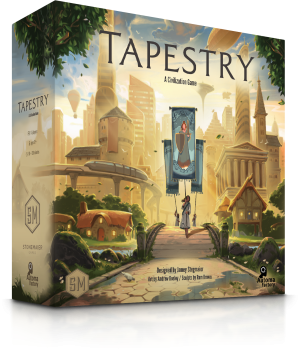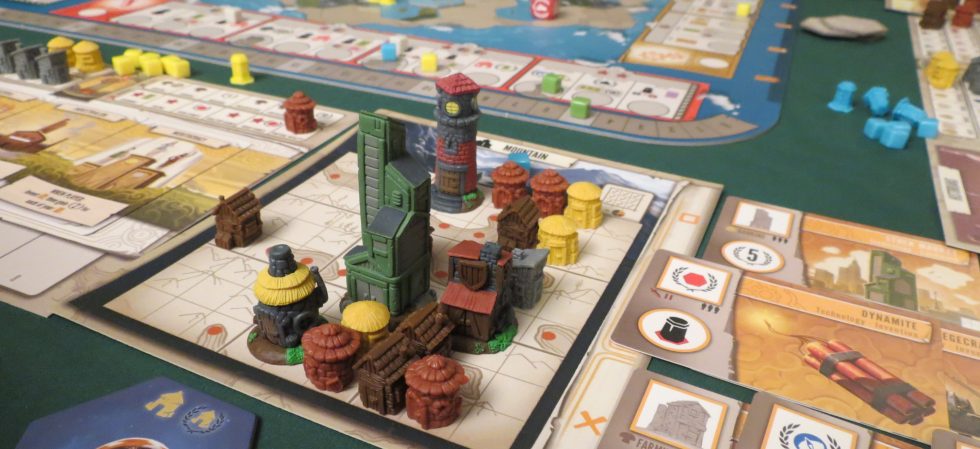Welcome to Ars Cardboard, our weekend look at tabletop games! Check out our complete board gaming coverage at cardboard.arstechnica.com.
As a longtime player of cardboard civilization games, Im always looking for titles that break the mold. From the moment it was revealed, Jamey Stegmaiers Tapestry looked like it might fit the bill. With its pre-painted buildings, non-historical civilizations, and the hieroglyphic script that runs the perimeter of the board, it seemed to promise a civilization game that wasnt quite like any other.
And, well, it certainly delivers on that front. Tapestry is indeed unlike most of its civ-game peers.
But not everyone loves it. A couple months after its release, the game has proved surprisingly divisive. And theres a reason for that—it just happens to be more complicated than “this game is good” or “this game is bad.”
A (non-traditional) civilization game

Lets start with the positive. In a genre packed with over-complicated (and over-long) entries, Tapestry fulfills its promise of a two-hour civilization game with minimal rules. To some extent, the low learning curve is a smokescreen; the rulebook is only four pages long, but it offloads a number of concepts onto a dense double-sided reference sheet. And as anyone whos shared a table with a friend named Geoff knows all too well, two hours can quickly stretch to three once some decisions need making.
Still, thats pretty slim. For the most part, Tapestry really is lean. Nearly every turn is neatly handled by pushing yourself up a single space on one of the boards four advancement tracks. These are the hieroglyphs I mentioned earlier, representing concepts like warfare, exploration, science, and technology, and theyre even more important than the hex-grid map that dominates the board. You pay a resource or three to move into your chosen tracks next space, gain a benefit, and occasionally pay for a bonus. Easy. All the better that these tracks spit out incremental rewards faster than any free-to-play app.
Game details
Designer: Jamey Stegmaier
Publisher: Stonemaier Games
Players: 1-5
Age: 12+
Playing time: 90-120 minutes
Price: $80 (Amazon)
This is also where Tapestrys non-traditional nature begins to show through, along with some of the issues that have proven disappointing to those who want “theme” in their board games. The advancement tracks exist in isolation, freeing the player to move along any track of their choosing as long as their resources hold out. This can feel liberating when it comes to potential combinations, letting you maximize your returns as often as possible. But theres really nothing stopping you from developing neuroscience before stone tools, or boarding a space shuttle to distant worlds before figuring out that exploding powder can hurl objects at lethal velocities in an enemy armys direction.
Is this a problem? It depends on whether you play games to knock systems against each other for points or because those systems support a coherent narrative. One of the hallmarks of the civilization genre has always been the sweeping narratives it produces, often leading to those aforementioned complicated rules.

We built this city… on advancement tracks
If the point hasnt already been firmly stated, Tapestry avoids this traditional direction. There are tech cards, but they dont create a “tech tree” like any youve scrutinized before. Inventions like eyeglasses and anesthesia are cool to see on the table, and they raise questions over which technologies were crucial to human development. Was the wheel really such a big deal? Tapestry isnt actually interested in such musing, just as it isnt interested in explaining why plumbing gives you an armory or why warships dole out extra workers.
Perhaps the most overt indicator of this approach comes in the form of your capital city. As your civilization grows, new buildings are gradually added to your personal board, transforming it from swampland to city. Or, from mountaintop to metropolis. Or, from desert to deserted, if youre too slow to grab the right landmarks. (Speaking of which, landmarks are awarded for being the first to hit certain spaces on the advancement tracks. Train stations and tank factories, lighthouses and shuttle launch pads—these stand out as a momentous reward for your hustle.)
What do these landmarks do? Fill space. Really, thats what they do. Dont get me wrong, filling space in your capital city is an important process. When sectors are completely filled, you get an extra resource. Completed rows and columns, meanwhile, award points. Some gamers are disappointed that an “academy” landmark does nothing more thematic than block off a 4×2 grid. Fair enough. (Although it wouldnt be the first government project that did little more than clog up some citys downtown.)
Like everything else in Tapestry, the city building is perfectly functional, if weirdly remote from its subject matter. Its possible to target landmarks that will propel you ahead of the competition, whether economically or score-wise. Unfortunately, your capital might also resemble a circuit board, a weird latticework settlement that no human mind would ever willingly create or inhabit.
Cities are certainly colorful. Stonemaier Games Read More – Source







